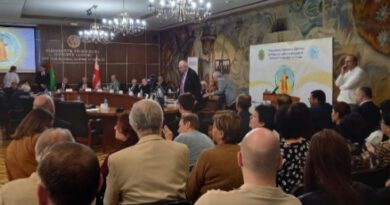Various Activities In Teaching Grammar
Every English teacher thinks about the “best” way to teach grammar, because there are many difficulties for students in teaching English grammar. Some grammar structures have exact parallels in their native language and that is why they are easy for students. Others have no such parallels but are simple in themselves, while still others are alien and very difficult to grasp.
Before planning a series of exercises for a particular grammar topic try to do your best to suggest to the students a number of interesting, game-like or communicative practice exercises. Everybody knows guessing games. Not only children like guessing, adults like guessing too. Nowadays there are many popular TV quiz programs. The basic rule of guessing games is very simple: one person knows something that another one wants to find out. We believe that guessing games are true communicative situations and are very important for foreign language learning. Students like them because they offer good language practice with fun and excitement.
Grammar can either be taught explicitly or implicitly. When we talk about an explicit approach to grammar we are talking about stating directly, usually at the beginning of a particular activity, what the grammar is. For example, “Today we are looking at the third conditional.” On the other hand an implicit approach to grammar is one where the students are ‘led’ to the grammar through a series of steps – this is what is meant by the ‘discovery technique’. In other words, the ‘discovery technique’ aims to lead students towards a generalized grammar rule or pattern.
”Discovery technique” is not the same as task-based learning. Certainly task-based learning is one form of ‘discovery technique’ but not the only way. In task-based learning the focus is on carrying out communicative tasks without specific focus on form. However, it is possible in the ‘discovery technique’ to be predominantly concerned with the form. The idea is that students will ‘discover’ the grammar through a series of steps (these might be tasks, language awareness activities, pictures, questions, etc.) and will deduce both the form and the meaning from the context(s).
Why should teachers use the ‘discovery technique’? One reason is that students often surprise teachers with what they already know or half-know. By using the ‘discovery technique’ teachers learn more about the students’ knowledge and abilities eliciting information from them rather than telling things to them. Also, as Scrivener writes: “Giving students chances to be exposed to, or to attempt to use, language ‘above’ their apparent level of knowledge of grammar is extremely useful and greatly aids future work on grammar.” This approach celebrates what students can do – and clarifies precisely what still needs to be worked on.
One approach to teaching language that has attracted a lot of attention over the past twenty-five years is a task-based approach to learning and teaching. In task-based approaches, the focus of classroom activities is on the task, and ultimately on meaning. In task-based learning model, learners begin by carrying out a communicative task, without specific focus on form. After they have done the task, they report and discuss how they accomplished this, perhaps listening to a fluent speaker doing the same task. Only at the end there is a specific focus on features of language form.
The advantage of the task-based approach, according to its advocates, is that during the task the learners are allowed to use whatever language they want, freeing them to focus entirely on the meaning of their message. This makes it closer to a real-life communicative situation.
One danger of task-based approaches is that focus on meaning could come at the expense of focus on form. Learners become quite fluent, but their utterances are not often accurate. In addition, they develop strategies to complete the tasks quite quickly, cutting corners in their language use and form.
There are a lot of various activities that can be used in teaching grammar effectively.
Activity One
Guessing Adjectival Phrases
This activity can be used at the beginning level. The aim of it is to develop speaking skills and to teach asking questions. The teacher can use a set of cards or slips of paper on each of which an adjective noun phrase is written.
One student is given a phrase (a card) and he/she tells the others only the noun. The other students have to guess the written phrase. For example, the “knower” gives the noun “girl” and the others might guess:
A good girl? A tall girl? A smart girl?
A teacher can help his/her students by giving hints to guess an adjective. He/she tells them when they are getting “warm”, and so on. The one who guesses the correct solution gets the next phrase.
| A tall boy | A clean dress | A smart girl |
| An interesting film | An expensive car | A clever dog |
| A fat baby | A high building | A long story |
| A good pupil | A kind cat | A funny monkey |
Later, next lesson, the students are given for their homework the assignment to think up their own combinations for guessing.
Activity Two
This activity aims at drilling simple present negative statements.
Students practice forming simple present negative statements. The teacher provides a sentence in the affirmative; students change it to the negative.
For example:
Teacher: Mary knows Jim.
Students (chorale response): Mary doesn’t know Jim.
Teacher: John likes that book.
Students (chorale response): John doesn’t like that book.
Scrambled Sentences are an excellent way to practice grammar recognition and syntax. You give students all the words to form one sentence in mixed-up order. Students then re-arrange the words to form a grammatically correct sentence.
Activity Three
Find Someone Who
This activity is a fun classroom activity that can be adapted for use with several different structures including Simple Past, Past Progressive, Present Perfect, and Past Perfect. Please note that the teacher can only use this activity for the Simple Present/Present Progressive if he/she has covered yes/no question formation.
The teacher should create a handout with two-column chart. Title the first column “Find someone who…” and the second column “Sentence.” Under the first column list 15-25 actions/states of being. (The more the teacher lists, the longer this activity will take.) The teacher should begin by reviewing interrogatives in the Present/Present Progressive. Next, describe a task similar to the ones listed in the first column of the chart. (For example, “plays the piano.”) Ask around the room until he/she finds someone who fits the description. (For example, “Merdan, do you play the piano?”) Then note down the first affirmative answer in a complete sentence on the board. (For example, “Merdan plays the piano.”)
Pass out one sheet to each student and explain that they are going to get up and walk around the room. They should ask their classmates questions in order to find someone to fit with each of the descriptions. Students can write down their results in complete sentences, like the one the teacher wrote on the board. They can also ask several questions of their own to find out more information about each activity. The teacher can participate in this activity or he/she can circulate to monitor for difficulties. After the students have had enough time to complete most of the sheet, check the answers by asking publicly to a response to each task.
Examples: The teacher can use the following activities in the first column of his/her chart: plays tennis, is living in a dorm, is working part time, likes this class very much, weighs 110 pounds, owns a car, and wants to visit India.
Activity Four
Guessing Games
These games are a fun way for beginners to review vocabulary words, practice forming structures, and listen for meaning. Simple Present can be used to describe habitual action. Students work in pairs or small groups to prepare a description of an animal. (For a longer activity have each group prepare 3-5 separate animal descriptions. Note that if you allow students to write out their descriptions, this becomes more like a focused practice activity.) Once students have prepared their descriptions, each group takes turns telling a description to the rest of the class, who then guess the name of the animal.
Example: A possible description of a rabbit could include, “It lives in a hole. It eats plants and vegetables. It has a lot of babies. It runs very fast.”
Activity Five
This activity aims at reviewing count and noncount nouns and irregular plural forms of the nouns. The teacher is to prepare the hand – out with the words below. It is preferable to copy them on to colored paper or cardstock. Cut up the words. Each group receives one “deck” of cards. Students take turns choosing words. The student must make a sentence using the word in a plural form; if the word is non-count, the student should use a quantifier to make a sentence. If the student answers correctly, he/she keeps the card. At the end, award a small prize to the student with the most cards.
Activity Twenty
Noun Clauses: Error Correction
Work with a partner and decide if each sentence below is correct or incorrect. If the sentence is incorrect, correct it.
1. That everyone here want to take a vacation is obvious.
2. Our teacher insists that we are here every day.
3. That students need to study it seems clear.
4.It is unlikely what we will get extra vacation time.
5.It is imperative that we be on time for the TOEFL test.
6. She recommended me go to Hawaii.
7. They advised we not get a cat.
8. Kristy, my good friend, warned me that he be unemployed.
9. It seems likely that will be cold again tomorrow.
10. It is important that he feeds the cats and gives them some attention every day while I’m away.
Note: There is only one correct sentence and that is sentence 5.
But grammar teaching has often been regarded as a structure based on formal activity. After the integration of several sources and techniques, which are mainly based on communicative activities, the teaching of grammar gained a new insight. In the teaching of grammar, technique-resource combinations are often modified to structure-discourse match and if well developed, they can be used effectively for all phases of a grammar lesson. In order to make a grammar lesson effective, beneficial, and interesting a teacher should use some well-developed and fascinating techniques in the classroom. In the present paper, the examples of such integrated sources and techniques -the use of songs, verse, games, and problem solving activities- will be clarified and several examples will be provided.
Being successful in teaching grammar evidently relies on teachers’ initiative to vary the material, create interesting and entertaining lessons, and mend the cracks in students’ background knowledge.
Jemal Atamuradova,Instructor of Magtymguly Turkmen State University,Ashgabat Turkmenistan.



